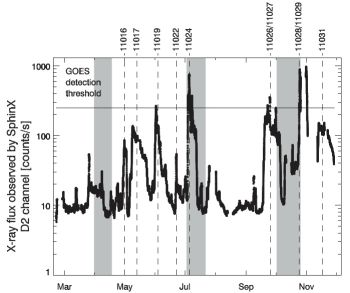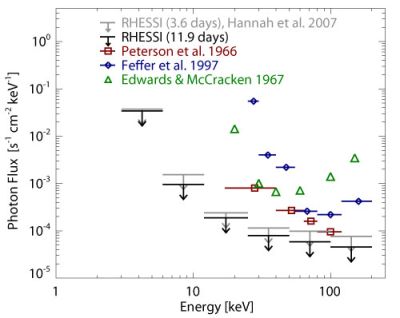Quiet Sun III: Difference between revisions
imported>Hhudson (Figures) |
imported>Schriste mNo edit summary |
||
| (6 intermediate revisions by 3 users not shown) | |||
| Line 6: | Line 6: | ||
|second_author = Hugh Hudson | |second_author = Hugh Hudson | ||
|publish_date = 2010 September 27 | |publish_date = 2010 September 27 | ||
|next_nugget = | |next_nugget = [[Sector Boundaries and RHESSI Flares]] | ||
|previous_nugget = [ | |previous_nugget = [[The X-ray Limb]] | ||
}} | }} | ||
== Introduction == | == Introduction == | ||
[[Image:F2.jpg|right|thumb|400px|<b>Figure 1:</b> Upper limits on the hard X-ray emission of the quiet Sun, including historical results and RHESSI data. See reference A for details.]] | |||
Earlier Nuggets, starting in 2005, have explored various facets of | Earlier Nuggets, starting in 2005, have explored various facets of | ||
high-energy radiation from the quiet Sun: | high-energy radiation from the quiet Sun: | ||
[ | {{#ask: [[Category:Nugget]] [[RHESSI Nugget Index::16]]}}, {{#ask: [[Category:Nugget]] [[RHESSI Nugget Index::21]]}}, {{#ask: [[Category:Nugget]] [[RHESSI Nugget Index::37]]}}, {{#ask: [[Category:Nugget]] [[RHESSI Nugget Index::50]]}}. | ||
[ | |||
[ | |||
[ | |||
Now we have the definitive RHESSI measurements in hand (reference A), in the | Now we have the definitive RHESSI measurements in hand (reference A), in the | ||
sense that the Sun has now passed (with difficulty) a | sense that the Sun has now passed (with difficulty) a quite unusual | ||
minimum], and RHESSI data acquisition for faint exotic hard X-ray emissions | [http://en.wikipedia.org/wiki/Solar_variation solar minimum], and RHESSI data acquisition for faint exotic hard X-ray emissions | ||
has come to an end. | has come to an end. | ||
| Line 31: | Line 30: | ||
though not by astronomical standards. | though not by astronomical standards. | ||
RHESSI's best observations are now completed because of competition from | RHESSI's best observations are now completed because of competition from | ||
increasing [solar activity] (see the discussion of "nanoflares" below). | increasing [http://www.scholarpedia.org/article/Solar_activity solar activity] (see the discussion of "nanoflares" below). | ||
== The new data == | == The new data == | ||
| Line 47: | Line 43: | ||
We discuss this latter result the "Nanoflares" section below. | We discuss this latter result the "Nanoflares" section below. | ||
Until focusing optics, such as those of [NuSTAR] or [FOXSI] become available, | Until focusing optics, such as those of [http://www.nustar.caltech.edu/ NuSTAR] | ||
or [http://cat.inist.fr/?aModele=afficheN&cpsidt=22321055 FOXSI] become available, | |||
these are the best hard X-ray data. | these are the best hard X-ray data. | ||
Figure 1 is the final statement from RHESSI on this topic owing to the | Figure 1 is the final statement from RHESSI on this topic owing to the | ||
increase of [solar activity]. | increase of [solar activity]. | ||
Other recent instruments (e.g., [SphinX]) or [MESSENGER] may improve | Other recent instruments | ||
(e.g., [http://sprg.ssl.berkeley.edu/~tohban/wiki/index.php/The_SphinX_Instrument_on_CORONAS-PHOTON SphinX]) | |||
or [http://messenger.jhuapl.edu/ MESSENGER] may improve | |||
on these limits, especially at lower energies, and we encourage the analysis | on these limits, especially at lower energies, and we encourage the analysis | ||
of such data on the quiet Sun. | of such data on the quiet Sun. | ||
| Line 60: | Line 59: | ||
== Nanoflares == | == Nanoflares == | ||
The Sun has a continuous but variable level of [magnetic activity], seen for | [[Image:136fig2.jpg|left|thumb|400px|<b>Figure 2:</b> The possible contributions of normal coronal activity to the hard X-ray spectrum.]] | ||
example as [plage], [flares], and [CMEs]. | |||
There is a hot [corona], brightest in | The Sun has a continuous but variable level of | ||
a well-known theory [Parker] suggested that "nanoflares" - tiny | [http://www.scholarpedia.org/article/Solar_activity solar magnetic activity], seen for | ||
example as [http://en.wikipedia.org/wiki/Plage_(astronomy) plage], | |||
[http://www.google.com/images?client=safari&rls=en&q=solar+flare&oe=UTF-8&um=1&ie=UTF-8&source=univ&ei=pOehTNKHEpK6sQP237h7&sa=X&oi=image_result_group&ct=title&resnum=6&ved=0CEoQsAQwBQ&biw=1056&bih=647 flares], | |||
and [http://www.windows2universe.org/sun/cmes.html CMEs]. | |||
There is a hot [http://imagine.gsfc.nasa.gov/docs/science/mysteries_l1/corona.html corona], brightest in sunspot regions, and in | |||
a well-known theory [http://en.wikipedia.org/wiki/Eugene_Parker Parker] suggested that "nanoflares" - tiny | |||
non-thermal energy releases, undetectable individually but very numerous, | non-thermal energy releases, undetectable individually but very numerous, | ||
could merge together and explain the heating needed. | could merge together and explain the heating needed. | ||
In essence the nanoflare hypothesis involves episodic heating, perhaps | In essence the nanoflare hypothesis involves episodic heating, perhaps | ||
resembling the action of true solar flares; to support a mean coronal | resembling the action of true solar flares; to support a mean coronal | ||
temperature means | temperature means mathematically that impulsive nanoflare heating | ||
would produce temperatures higher than the mean. | would produce temperatures higher than the mean. | ||
In other words, the instantaneous temperature distribution of the | In other words, the instantaneous temperature distribution of the | ||
| Line 74: | Line 78: | ||
has to attain the mean coronal temperature. | has to attain the mean coronal temperature. | ||
If the nanoflares were physically similar to ordinary flares, we | If the nanoflares were physically similar to ordinary flares, we | ||
would also expect bursts of | would also expect bursts of hard X-ray bremsstrahlung (see Reference [A]). | ||
This component of quiet-Sun emission should be detectable by an | This component of quiet-Sun emission should be detectable by an | ||
appropriately sensitive measurement. | appropriately sensitive measurement. | ||
See reference [B] for fuller background. | See reference [B] for fuller background. | ||
[[Image: | [[Image:136fig3.jpg|right|thumb|350px|<b>Figure 3:</b> Time-series photometry of the truly quiet Sun, as recorded by [http://sprg.ssl.berkeley.edu/~tohban/wiki/index.php/The_SphinX_Instrument_on_CORONAS-PHOTON SphinX].]] | ||
In Figure | In Figure 3 we show recent observations from the SphinX experiment. | ||
It makes sensitive soft X-ray observations with spectral resolution | It makes sensitive soft X-ray observations with spectral resolution | ||
somewhat better than RHESSI's, and greatly improves on the standard | somewhat better than RHESSI's, and greatly improves on the standard | ||
| Line 94: | Line 98: | ||
the mean.. | the mean.. | ||
== Conclusions == | == Conclusions == | ||
| Line 102: | Line 106: | ||
RHESSI cannot improve on these limits for another several years, | RHESSI cannot improve on these limits for another several years, | ||
and there are no plans now for new and more sensitive hard X-ray | and there are no plans now for new and more sensitive hard X-ray | ||
solar instrumentation (but we look forward to | solar instrumentation (but we look forward to FOXSI and NuSTAR). | ||
These limits may stand as definitive ones for some time to come. | These limits may stand as definitive ones for some time to come. | ||
In the meanwhile it is important to study the 1-10 keV range with | In the meanwhile it is important to study the 1-10 keV range with | ||
| Line 111: | Line 115: | ||
== References == | == References == | ||
[A] ["Constraining the hard X-ray properties of the quiet sun with new | [A] [http://arxiv.org/abs/1009.2918 "Constraining the hard X-ray properties of the quiet sun with new RHESSI observations"] | ||
RHESSI observations"] | |||
[B] [http://arxiv.org/abs/astro-ph/0511841 "On solving the coronal heating problem"] | |||
[ | [[Category: Nugget]] | ||
Latest revision as of 17:24, 23 August 2018
| Nugget | |
|---|---|
| Number: | 136 |
| 1st Author: | Iain Hannah |
| 2nd Author: | Hugh Hudson |
| Published: | 2010 September 27 |
| Next Nugget: | Sector Boundaries and RHESSI Flares |
| Previous Nugget: | The X-ray Limb |
Introduction
Earlier Nuggets, starting in 2005, have explored various facets of high-energy radiation from the quiet Sun: Exploring the Quiet Sun 1, A Solar Hard X-Ray Halo: Exploring the Quiet Sun 2, Solar radiation belts?, Solar X-rays from axions. Now we have the definitive RHESSI measurements in hand (reference A), in the sense that the Sun has now passed (with difficulty) a quite unusual solar minimum, and RHESSI data acquisition for faint exotic hard X-ray emissions has come to an end.
Reference to the earlier Nuggets cited will bring up unusual subjects such as cosmic-ray electrons, albedo neutrons, axions, and the diffuse cosmic X-ray background. Since RHESSI only obtains upper limits, we cannot say very much about these interesting things, except that they are predicted to be very faint, though not by astronomical standards. RHESSI's best observations are now completed because of competition from increasing solar activity (see the discussion of "nanoflares" below).
The new data
In Reference A we describe the full observing program for faint global hard X-ray emission from the Sun. It has resulted in better upper limits rather than in a positive detection (see Figure 1). Not only does RHESSI not detect any of the more exotic possible sources; these limits also exclude low levels of "normal" magnetic activity. We discuss this latter result the "Nanoflares" section below.
Until focusing optics, such as those of NuSTAR or FOXSI become available, these are the best hard X-ray data. Figure 1 is the final statement from RHESSI on this topic owing to the increase of [solar activity]. Other recent instruments (e.g., SphinX) or MESSENGER may improve on these limits, especially at lower energies, and we encourage the analysis of such data on the quiet Sun. As discussed below high spectral resolution may be very important in this domain, as well as good background rejection, to distinguish exotic sources from the expected magnetic signatures (see next section).
Nanoflares
The Sun has a continuous but variable level of solar magnetic activity, seen for example as plage, flares, and CMEs. There is a hot corona, brightest in sunspot regions, and in a well-known theory Parker suggested that "nanoflares" - tiny non-thermal energy releases, undetectable individually but very numerous, could merge together and explain the heating needed. In essence the nanoflare hypothesis involves episodic heating, perhaps resembling the action of true solar flares; to support a mean coronal temperature means mathematically that impulsive nanoflare heating would produce temperatures higher than the mean. In other words, the instantaneous temperature distribution of the corona would be broader than for a steady heating process that only has to attain the mean coronal temperature. If the nanoflares were physically similar to ordinary flares, we would also expect bursts of hard X-ray bremsstrahlung (see Reference [A]). This component of quiet-Sun emission should be detectable by an appropriately sensitive measurement. See reference [B] for fuller background.

In Figure 3 we show recent observations from the SphinX experiment. It makes sensitive soft X-ray observations with spectral resolution somewhat better than RHESSI's, and greatly improves on the standard [GOES] soft X-ray data. The point of this figure is that the data show periods of quiet coronal emission, with no flares; even during the presence of active regions, there are apparently steady emission levels. This absence of flare-like variation suggests that the physics of nanoflares, if they exist, is quite different from that of flares. The real test will be in the spectroscopy, ie in the search for significant broadening of the temperature distribution away from the mean..
Conclusions
This Nugget reports the best upper limits on hard X-rays from the quiet Sun, including several possible mechanisms. RHESSI cannot improve on these limits for another several years, and there are no plans now for new and more sensitive hard X-ray solar instrumentation (but we look forward to FOXSI and NuSTAR). These limits may stand as definitive ones for some time to come. In the meanwhile it is important to study the 1-10 keV range with available data. Because the thermal spectra are steep, spectroscopic observations are important.
References
[A] "Constraining the hard X-ray properties of the quiet sun with new RHESSI observations"

